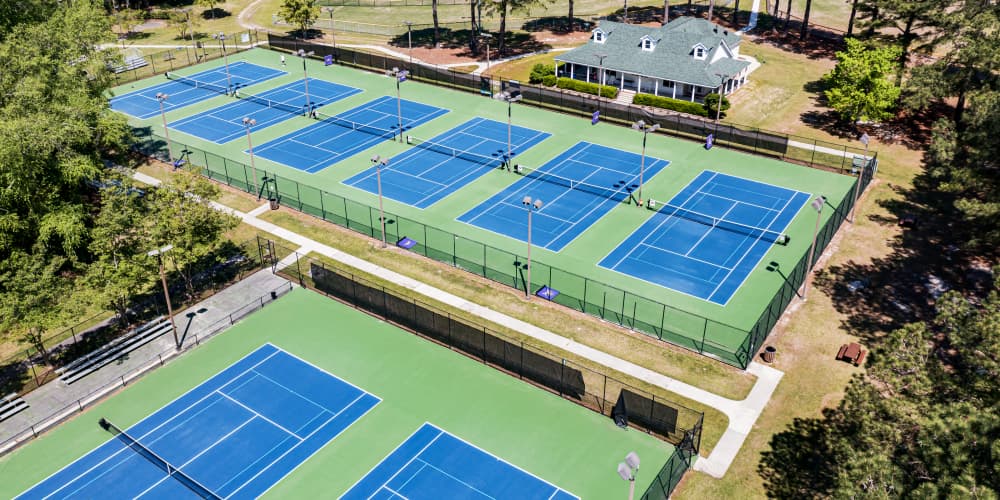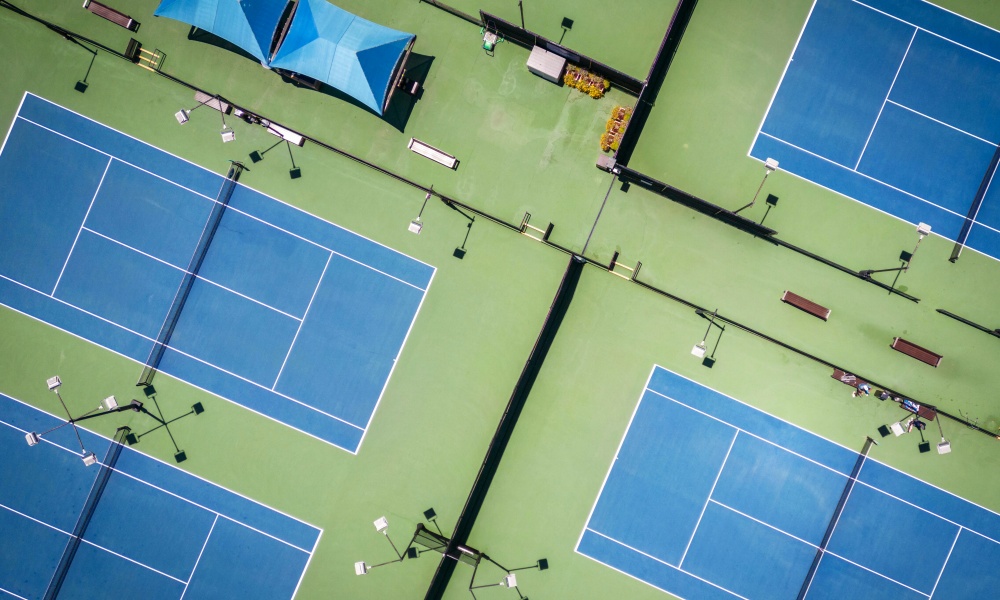Should I Upgrade My Tennis Court Lights to LED?

Table of Contents
Why Consider Upgrading or Retrofitting to LED?
When LED Upgrades Are a No-Brainer?
When You Might Hold Off (For Now)?
LED vs. Metal Halide: Quick Comparison Table
Key Questions to Ask Before You Upgrade
FAQs About LED Tennis Court Lights
Final Verdict: When LED Is Worth the Investment
Why Consider Upgrading or Retrofitting to LED?
If you've been using metal halide or HID lamps on your tennis court for years, you've probably noticed their limits — slow warm-up, high energy bills, and frequent bulb replacements. That's why many facility owners today are asking a simple question: Should I upgrade or retrofit my tennis court lights to LED?
LED tennis court lighting has rapidly become the standard for both residential and commercial courts. The reason is simple: it delivers brighter, more uniform illumination while cutting energy use by up to 60%. Unlike traditional lamps, LED fixtures start instantly, produce less heat, and maintain consistent brightness for years without fading.
Upgrading — or retrofitting — doesn't just improve visibility. It enhances player experience, reduces maintenance costs, and aligns your facility with modern energy standards. Whether you manage a sports club or own a private court, switching to LED is one of the smartest long-term investments you can make in your court lighting system.
In the next sections, we'll explore when LED upgrades make the most sense, when you might hold off, and how to decide what's best for your court setup.

When LED Upgrades Are a No-Brainer?
In many cases, switching to LED lights isn't just an option — it's an obvious win. If any of the following situations sound familiar, upgrading your tennis court lighting system will quickly pay off.
Situation 1: You're Still Using Metal Halide or HID Lamps
Traditional lamps waste a lot of energy as heat and take 10–15 minutes to reach full brightness. They also fade over time, causing uneven lighting across the court.
By contrast, LED tennis court lighting turns on instantly, delivers consistent brightness, and lasts 5–10 times longer. Most LEDs run for 50,000–100,000 hours, compared to just 8,000–12,000 for HID bulbs.
Situation 2: You Want Better Visibility and Player Experience
Good lighting makes a difference in every match. LED lights offer higher color rendering (CRI 80–90), meaning the ball's spin, lines, and surface color appear more natural and easier to see.
They also provide uniform coverage with less glare — a big advantage for night games and televised events.
Situation 3: You're Tired of High Energy and Maintenance Costs
Energy efficiency is one of LED's biggest strengths. A set of LED tennis court lights can cut electricity use by 40–60%, saving hundreds of dollars annually.
You'll also eliminate frequent bulb changes and maintenance downtime, which makes a major difference for sports clubs or public courts that operate daily.
Situation 4: Your Court Hosts Events or Night Matches
For venues that hold tournaments or evening sessions, instant start-up means no waiting before play, and the lights can be dimmed or programmed for different brightness levels — perfect for training, match play, or special events.
Situation 5: You're Looking for a Long-Term Investment
While LED fixtures cost more upfront, they deliver clear ROI through energy savings, longer lifespan, and fewer service calls. Over a 5-year period, most facilities recover their initial investment — and continue saving afterward.
Situation 6: Your Court Accommodates Multiple Sports (Tennis, Pickleball & Basketball)
For venues that host not only tennis matches but also cater to pickleball, basketball, and other sports, upgrading to an intelligent LED lighting system is essential — it seamlessly switches between specialized modes for pickleball lighting, basketball lighting, and tennis court lighting.
With programmable settings tailored to each sport's unique illuminance, uniformity, and glare control needs, the system eliminates the hassle of manual adjustments, ensuring optimal visibility for every game held on your multi-purpose court.
If your tennis court fits any of these conditions, upgrading or retrofitting to LED isn't just smart — it's overdue.
When You Might Hold Off (For Now)?
While LED tennis court lighting offers clear benefits, it's not always the right time for everyone to make the switch. In some cases, waiting a little longer can be the smarter financial choice.
Situation 1: Your Current Lights Are Still New
If you recently installed metal halide or other HID fixtures — especially ones that are LED-compatible — it might be better to wait until the bulbs near the end of their lifespan. Replacing working lights too soon can waste money, even if the upgrade will eventually pay off.
Situation 2: Your Court Sees Limited Use
For a private or residential tennis court used only once or twice a week, the electricity savings from LED lights might take years to offset the initial investment. In this case, upgrading can wait until you’re ready for other improvements or until maintenance costs rise.
Situation 3: You're Planning a Major Renovation Soon
If you expect to resurface your court, change the layout, or replace the tennis court light poles in the next year or two, it's more efficient to plan your lighting upgrade at the same time. This avoids rewiring twice and ensures your lighting design perfectly fits the new setup.
Situation 4: Your Existing System Is Still Performing Well
Some modern HID systems with efficient ballasts and proper maintenance can still provide decent illumination. If brightness levels and color uniformity meet your needs, there's no rush — just start planning for LED when performance starts to drop.
Bottom line: If your current tennis court lighting is still in good shape, lightly used, or part of a near-term renovation plan, holding off makes sense. But once those factors change, LED will almost always be the better long-term move.
LED vs. Metal Halide: Quick Comparison Table
Before deciding whether to retrofit your lighting system, it helps to see how LED and metal halide lights compare in real performance. The difference is clearer than you might think.
Feature | LED Tennis Court Lights | Metal Halide / HID Lights |
Energy Efficiency | 40–60% lower energy use; converts more electricity into light | High power consumption; much wasted as heat |
Lifespan | 50,000–100,000 hours (10+ years of typical use) | 8,000–12,000 hours; frequent bulb changes |
Warm-Up Time | Instant on/off with no delay | Requires 10–15 minutes to reach full brightness |
Light Quality (CRI) | CRI 80–90; bright, natural colors | CRI 60–70; yellowish and uneven over time |
Uniformity | Even illumination across the court | Bright and dark spots common as lamps age |
Maintenance | Minimal; no bulb replacements | High maintenance and recurring costs |
Heat Output | Low; stays cool during operation | High; most energy lost as heat |
Control Options | Dimmable and smart-control ready | Fixed brightness; no dimming support |
Environmental Impact | Mercury-free, recyclable materials | Contains mercury; hazardous disposal required |
Why This Comparison Matters?
LED tennis court lighting outperforms metal halide in every major area — from brightness and energy savings to safety and maintenance. While HID systems once dominated outdoor sports lighting, modern LED fixtures now deliver better visibility with far less hassle and long-term cost.
If your current court still uses metal halide lamps, this table shows why upgrading or retrofitting to LED is one of the most impactful improvements you can make.
Key Questions to Ask Before You Upgrade
Upgrading your LED tennis court lighting design is not just about replacing old fixtures — it's about ensuring every detail supports performance, visibility, and long-term value. Before you move forward, here are the key questions to ask:
Question 1: What Illumination Level Do You Need?
Different levels of play demand different brightness standards. According to ITF recommendations, the typical illuminance requirements are:
250 lux – recreational or training courts
350 lux – club-level matches
450 lux and above – professional or televised events
Evaluating your venue's purpose and audience ensures you select the right tennis court lights upgrade that balances visibility with energy efficiency.
Question 2: Is the Lighting System Waterproof and Dustproof?
Tennis courts face various weather conditions, especially outdoor ones. Always check for IP65 or higher protection, which guarantees resistance against rain, dust, and high humidity. This ensures stable operation and prevents costly maintenance or flicker issues over time.
Question 3: Does the Manufacturer Offer Long-Term Warranty and Support?
High-quality LED court lights should come with a 5–10 year warranty, reflecting confidence in product durability and after-sales service. A long warranty not only reduces total ownership costs but also shows the manufacturer's commitment to product quality and performance stability. Ceramiclite provides 10-year warraty with better aftersale service.
Question 4: Are the Pole Height and Angle Properly Designed?
The tennis court light pole height directly affects lighting uniformity and glare control. Typically, poles range between 8–12 meters depending on court layout and competition level.
Make sure your designer or contractor optimizes:
l Mounting height and beam angle for even light coverage
l Pole positioning (usually behind the baseline or along the sidelines) to reduce shadows and glare
l Compatibility with LED fixtures' beam patterns
A proper LED tennis court lighting design integrates these factors to achieve professional-level visibility while maintaining comfort for players and spectators.
FAQs About LED Tennis Court Lights
Below are the most frequently asked questions about LED tennis court lights—covering cost, installation, retrofit options, and lifespan.
Q1: What is the average cost to upgrade tennis court lights to LED?
The LED tennis court lights cost typically ranges from $3,000–$6,000 per court. The final price depends on factors such as pole height, wattage, and the number of fixtures required to achieve the desired brightness level.
While the initial cost may seem higher than traditional lighting, the long-term savings in energy and maintenance make LEDs a more economical choice.
Q2: How many LED lights do I need for a tennis court?
A standard outdoor tennis court usually needs 6–8 LED fixtures, each between 400–600 watts, to deliver balanced illumination and consistent coverage. The exact number may vary depending on court layout, mounting height, and lighting design standards.
Q3: Can I replace my metal halide bulbs with LED?
Yes. Many modern LED systems support tennis court light retrofit installations. They can use existing poles and wiring, reducing both labor and material costs. Retrofit kits are ideal for facilities looking to improve energy efficiency without completely rebuilding their lighting structure.
Q4: Do LED tennis court lights get hot?
No, they operate at much cooler temperatures than traditional metal halide lamps. LEDs convert most of their power into light instead of heat, resulting in better efficiency and safer operation. Even after hours of use, fixtures are only mildly warm to the touch.
Q5: How long do LED tennis court lights last?
The typical LED tennis court lighting lifespan is between 50,000 and 100,000 hours, equivalent to 10 years or more of regular use. This greatly outperforms HID or halogen lamps, reducing replacement frequency and overall maintenance costs.
Final Verdict: When LED Is Worth the Investment
For most tennis court owners, LED upgrades are a long-term win—they save money, improve play, and cut maintenance headaches. The only exception? If your current lights are new, or your court is barely used. But if you’re tired of waiting for bulbs to warm up, replacing burnt-out lamps, or paying high electricity bills—this is the upgrade for you.
In the long run, LED technology offers unmatched ROI and sustainability. Reduced energy bills, extended fixture lifespan, and improved playability make it an investment that pays off year after year—both financially and environmentally.
Looking to retrofit your tennis court lighting system?
Contact us today for a free LED layout design and cost estimate!
Related Product
.png)
_thumb.jpg)
